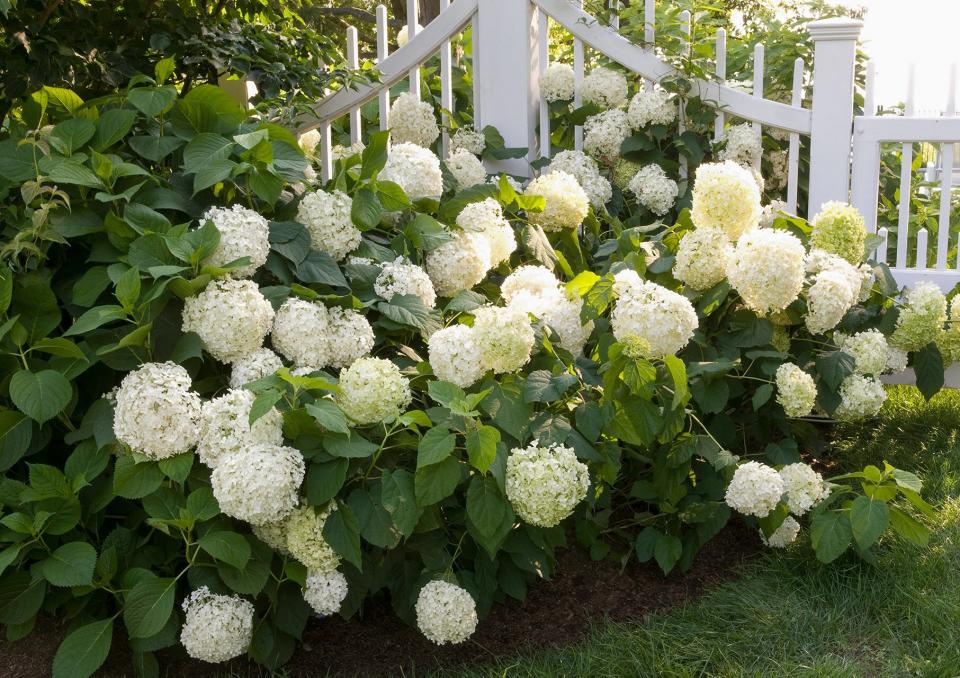How to Choose the Best Hydrangeas to Grow in Your Garden
Mopheads and lacecaps and oakleaves, oh my! Each of these hydrangea types offers large, ruffled blooms on easy-to-maintain plants that make beautiful additions to your landscape. But there are tons of varieties to choose from, offering different colors, leaves, growth patterns, and sizes. Plus, exciting new varieties keep appearing, each one sounding even better than the next. So where do you start when you're trying to pick the best hydrangea varieties for your yard? You've come to the right place. This straightforward guide will help you find the best hydrangea for the soil conditions, sun and shade amounts, and moisture levels of your garden.

Bob Stefko
The Best Hydrangeas for Full Sun
While several species of hydrangeas thrive in shade, panicle hydrangeas (Hydrangea paniculata) are the best for growing in full sun. These summer-blooming shrubs produce large clusters of white flowers for several weeks. The showy blooms fade to shades of pink or red before drying to beige. In many areas, the blooms dry on the plant in the fall and continue looking good through most of the winter. Hydrangea paniculata is one of the hardiest species; it thrives in Zones 4-8.
Outstanding Panicle Hydrangea Varieties
'Grandiflora' is sometimes called peegee hydrangea. It's a large shrub or small hydrangea tree up to 20 feet tall.
'Limelight' bears light lime-green flowers from midsummer to fall. It grows eight feet tall.
Vanilla Strawberry (Hydrangea paniculata 'Rehny') bears large clusters of white flowers that fade to strawberry pink from midsummer to autumn. It grows about seven feet tall.

Matthew Benson
The Best Cold-Climate Hydrangea
Smooth hydrangea (Hydrangea arborescens), also sometimes called hills of snow or snowball hydrangea, is an especially easy-growing type that's native to North America. It has clusters of pure white flowers from midsummer into autumn; the older flowers often fade to green before they turn brown and dry. This extra-hardy hydrangea thrives in Zones 3-9 in part shade. While it can take cold temps, it is not very drought tolerant, especially if it's in a spot that gets afternoon sun. Be sure to water it during dry spells and add a two- to four-inch-deep layer of mulch on the soil around its base to help slow down water evaporation.
Popular Smooth Hydrangea Varieties
'Annabelle' bears extra-large clusters of white flowers. It grows five feet tall.
'White Dome' bears fluffy clusters of creamy-white flowers. It grows six feet tall and is hardy in Zones 4-9.

Marty Baldwin
The Best Easy-Care Hydrangeas
Elegant oakleaf hydrangea is one of the easiest types to grow. It's also one of the showiest, thanks to its big clusters of white summertime flowers, attractive peeling bark, and textured foliage that turns brilliant shades of purple-red in fall. Oakleaf hydrangea grows about eight feet tall, making it a good choice for providing summertime privacy or as a backdrop in the shade garden. Like smooth hydrangea, it's native to North America, and it also prefers a spot in part shade or even full shade. It stands up to dry soil a bit better than most other types, but still appreciates extra water during droughts. Oakleaf hydrangea is hardy in Zones 5-9.
Favorite Oakleaf Hydrangea Varieties
'Alice' offers extra-large blooms and more spectacular fall color. It grows 10 feet tall.
'Little Honey' has golden-yellow foliage and clusters of white summertime flowers. It grows four feet tall.
'Snowflake' bears clusters of double white flowers. It grows eight feet tall.

Erica George Dines
The Best Hydrangeas for Season-Long Color
It used to be that the beautiful blue- and pink-blooming bigleaf hydrangeas (Hydrangea macrophylla) would bloom once a year, usually in June. But plant breeders have been hard at work, and their efforts are paying off in a new type of hydrangea: rebloomers. Series such as Endless Summer and Let's Dance offer big, colorful mophead or lacecap type blooms every few weeks in summer and fall. Many of these varieties offer beautiful fall foliage, too, and are hardy in Zones 5-9.
Reblooming hydrangeas prefer a spot that gets morning sun and afternoon shade. They aren't very drought tolerant so will do best in moist, but well-drained soil. You'll also need to give them extra water during dry spells. Otherwise, cutting off fading blooms will encourage the plant to continue producing even more flowers.
Test Garden Tip: The level of acidity in the soil affects the flower color of blue and pink varieties. The more acidic the soil is, the bluer the flowers will be; the less acidic, the pinker the flowers will be. Add soil sulfur or aluminum sulfate for bluer flowers and add dolomitic lime for pinker flowers.

Marty Baldwin
Standout Varieties of Reblooming Hydrangeas
Endless Summer bears mophead clusters of pink or blue flowers. It grows five feet tall.
Let's Dance 'Moonlight' bears rich blue or pink mophead-type flowers. It grows five feet tall.
Let's Dance 'Starlight' bears rich blue or pink lacecap-type flowers. It grows five feet tall.

Lynn Karlin
Best Hydrangea for Shade
The most unusual member of the clan, climbing hydrangea (Hydrangea petiolaris) is a very slow-growing vine that thrives in full shade in Zones 4-8. It can grow up to 50 feet on a sturdy support. In summer, it bears lacecap-like clusters of white flowers over its rich green foliage.
Select These Standout Varieties
'Firefly' bears green leaves edged in gold and clusters of white flowers.
'Skylands Giant' bears extra large flower clusters.
Hydrangeas Are Poisonous
Regardless of the variety, all parts of hydrangeas are poisonous to cats, dogs, and other animals, including humans, if eaten. Make sure to supervise pets and small children around hydrangeas in your garden, and keep the cut flowers in your home out of reach.
Related: 8 Pretty but Dangerous Garden Plants to Grow with Caution

